Market Overview
This week, the cryptocurrency market showed a volatile downward trend. Bitcoin continued its oscillating decline from last week, while altcoins generally followed the market trend with similar fluctuations. The market sentiment index slightly decreased from last week's 30% to 28%, remaining in the bearish range.
Stablecoin Market Dynamics
The stablecoin market maintained an upward trend from last week, showing a synchronized increase in USDT and USDC:
USDT: Market capitalization reached $155.7 billion, with a week-on-week growth of 0.32%. Although it continues to rise, the weekly influx of new funds recently fell below $1 billion for the first time, indicating a decrease in the intensity of capital inflow.
USDC: Market capitalization was $61.4 billion, with a week-on-week growth of 0.33%, ending last week's downward trend and beginning to show a slight increase.
This phenomenon is worth investors' attention: although USDT's market capitalization continues to rise, it only increased by $500 million this week, ending a streak of six consecutive weeks with over $1 billion in weekly growth. This indicates a decline in the strength of capital inflow primarily from non-U.S. users, and given USDT's diverse uses, the actual funds entering the crypto market may be less than $500 million. The increase in USDC's market capitalization this week reflects a renewed entry of funds primarily from U.S. investors. Although only $200 million entered this week, this signal needs to be monitored continuously.
Market Performance Divergence
This week, the cryptocurrency market exhibited a clear structural divergence: Bitcoin maintained a volatile downward trend, while altcoins faced significant declines. This divergence reflects a risk-averse characteristic where funds concentrate on relatively safe assets in an uncertain environment, highlighting Bitcoin's status as a "safe haven" in the cryptocurrency space.
Escalation of Geopolitical Risks
Intensified Middle East Conflict: The conflict between Israel and Iran continues to escalate, with the U.S. increasing its military deployment around Iran, raising market concerns about direct U.S. involvement in the conflict.
Risk Transmission Mechanism: The geopolitical tensions directly impact risk assets through a decline in risk appetite, with cryptocurrencies, as high-risk assets, being particularly vulnerable, especially altcoins with relatively poor liquidity.
Shift in Monetary Policy Expectations
Fed's Hawkish Stance: Although this week's interest rate meeting maintained the 4.5% rate as expected, the meeting minutes indicated a subtle change in policymakers' attitudes.
Significant Reduction in Rate Cut Expectations: The number of officials not favoring a rate cut increased to seven, with expectations for rate cuts in 2025 reduced from two to one. This shift in expectations directly undermines the market's anticipation of liquidity easing.
Adjustments in Economic Expectations: The Fed simultaneously lowered growth expectations while raising inflation expectations, exacerbating concerns about "stagflation" and further fueling market pessimism.
Favorable Policy Factors
Positive Legislative Progress: The "GENIUS Act" passed significantly in the U.S. Senate, providing policy support for the development of the cryptocurrency industry.
Stablecoin Market Outlook: Treasury Secretary Yellen expects the stablecoin market to reach $3.7 trillion by the end of 2029, injecting confidence into the long-term development of the cryptocurrency ecosystem.
Limited Sentiment Boost: Despite favorable policies, the positive impact is relatively limited under the dual pressures of geopolitical risks and tightening monetary policy.
Investment Strategy Recommendation: Cautious Defense
Rising Risk Aversion: As the Middle East geopolitical crisis continues to unfold, global risk aversion may further intensify, continuing to suppress risk assets.
Increased Market Vulnerability: Under the intertwining of multiple uncertainties, the volatility and fragility of the cryptocurrency market have significantly increased, and the risk of flash crashes cannot be ignored.
Cautious Strategy Recommendation: Investors should remain highly cautious, closely monitor the developments of geopolitical events, appropriately control positions, and guard against sudden risk events that could significantly impact their portfolios.
Market Outlook
In the coming week, the cryptocurrency market will continue to face severe challenges. The further escalation of geopolitical conflicts in the Middle East and the possibility of U.S. military intervention will continue to heighten global risk aversion. Coupled with the tightening monetary policy expectations reinforced by the Fed's hawkish stance, Bitcoin is expected to struggle to balance its safe-haven attributes and risk asset characteristics, while altcoins may face greater selling pressure and liquidity exhaustion risks. Under the multiple pressures of testing key technical support levels, cautious institutional capital, and potentially escalating retail panic, the market faces risks of flash crashes and chain reactions. Investors should adopt defensive strategies, strictly control positions and leverage, and closely monitor geopolitical dynamics and important economic data to guard against severe market fluctuations triggered by unexpected events.
Next Week's Forecasted Targets
Bullish Target: AERO
AERO: Analysis of Ecological Leader Value Reassessment and Strategic Opportunities Under Coinbase's Integration of Base Chain DEX
Last weekend, Max Branzburg, Vice President of Product Management at Coinbase, announced that Coinbase will integrate the DEX on the Base chain into its main application, with future applications embedding DEX trading.
- Fundamental Impact of Liquidity Integration
Liquidity Foundation from Platform Scale Effects
As a leading exchange in the industry, Coinbase has over 100 million registered users and 8 million monthly active trading users, with customer asset values reaching $428 billion. This vast user base and asset scale provide an unprecedented source of liquidity for the Base chain DEX. When these users access the Base chain DEX directly through the Coinbase main application, it will create a large-scale liquidity inflow effect.
Structural Advantages of Institutional Capital
Data shows that the proportion of institutional trading volume on the Coinbase platform continues to rise, reaching 82.05% ($256 billion) in Q1 2024, while retail trading only accounts for 18%. This institutionally dominated trading structure means that the funds entering the Base chain have stronger stability and larger individual transaction sizes, which helps enhance the trading depth of the DEX and reduce slippage.
Competitive Advantages from Market Concentration
Aerodrome, as the largest DEX project in the Base ecosystem, accounts for about 60% of the trading volume of the entire Base ecosystem DEX. According to the liquidity aggregation effect, new liquidity will preferentially flow to the platform with the highest trading volume and best depth. Aerodrome's market leadership makes it the primary recipient of Coinbase's liquidity.
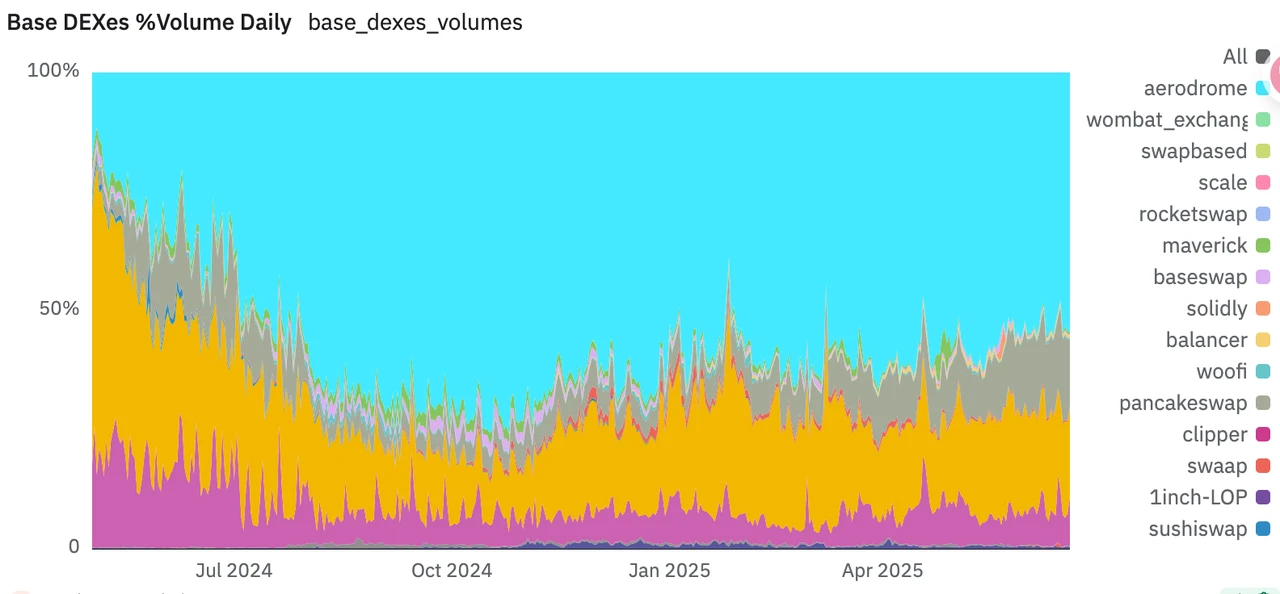
Proportions of DEX Trading Volume in the Base Chain (Data Source: https://dune.com/xdromeanalytics/base-dex-landscape)
- Economic Model Analysis Benefiting Aerodrome
Positive Circular Mechanism of Token Economics
Incentive Structure for Revenue Distribution
Aerodrome adopts a 100% revenue distribution mechanism: veAERO holders receive 100% of the fees and bribes from their voting pools, while LPs receive 100% of AERO emission incentives. This design ensures that the growth of protocol revenue can directly translate into increased earnings for token holders.
Supply Tightening Driven by Staking
As Coinbase's liquidity inflow boosts Aerodrome's trading volume and revenue, the APY for veAERO holders will significantly increase. High yields will incentivize more users to stake AERO as veAERO, thereby reducing the circulating supply of AERO and creating a positive cycle of supply-demand imbalance driving price increases.
Value Realization of Governance Weight
veAERO holders vote to decide the distribution of AERO emissions, and this governance weight becomes more valuable in a high liquidity environment. As protocol revenue grows, the economic value of governance rights will attract more long-term investors to participate in staking.
- Capacity Advantages of Technical Architecture
Efficiency Improvement from Multiple Technology Integrations
Aerodrome combines the token economics of Curve/Convex, the concentrated automated market maker (clAMM) of Uniswap v3, and the optimized Solidly codebase. This technological integration ensures that the platform can efficiently handle large-scale liquidity, providing users with better trading execution.
Competitive Advantage in Capital Efficiency
The clAMM technology achieves capital-efficient exchanges, providing lower slippage and better price execution under the same liquidity conditions. After the liquidity injection from Coinbase, this technological advantage will be further amplified, solidifying Aerodrome's competitive position in the Base ecosystem.
Long-term Assurance of Scalability
Aerodrome's technical architecture has good scalability, capable of accommodating large-scale capital inflows without affecting system stability. This provides a technical foundation for its long-term benefits from Coinbase's integration.
On-chain Data Analysis

Aerodrome's TVL (Data Source: https://defillama.com/protocol/aerodrome)
As shown in the above chart, Aerodrome's TVL reached a low point in early April and has since rebounded rapidly, now reaching $1 billion, with a rebound of 56%.

Aerodrome's Trading Volume (Data Source: https://defillama.com/protocol/aerodrome)
From the above chart, it can be seen that Aerodrome's trading volume experienced a rapid and significant increase after Coinbase announced the integration of the DEX on the Base chain into its main application. The trading volume peaks often coincide with trading days from Monday to Friday, while trading volume shows a noticeable decline on weekends, indicating a clear influx of funds from Coinbase into Aerodrome.
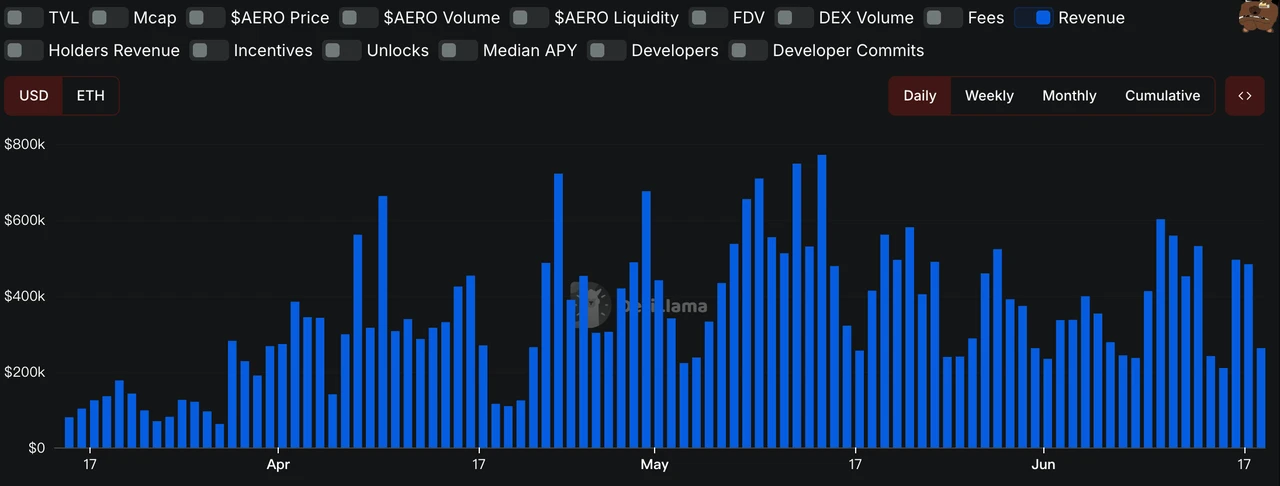
Aerodrome's Project Revenue (Data Source: https://defillama.com/protocol/aerodrome?dexVolume=false&tvl=false&revenue=true)
From the above chart, it can be seen that Aerodrome's project revenue has rapidly increased following the announcement of Coinbase integrating the DEX on the Base chain into its main application, aligning closely with Coinbase's trading times.
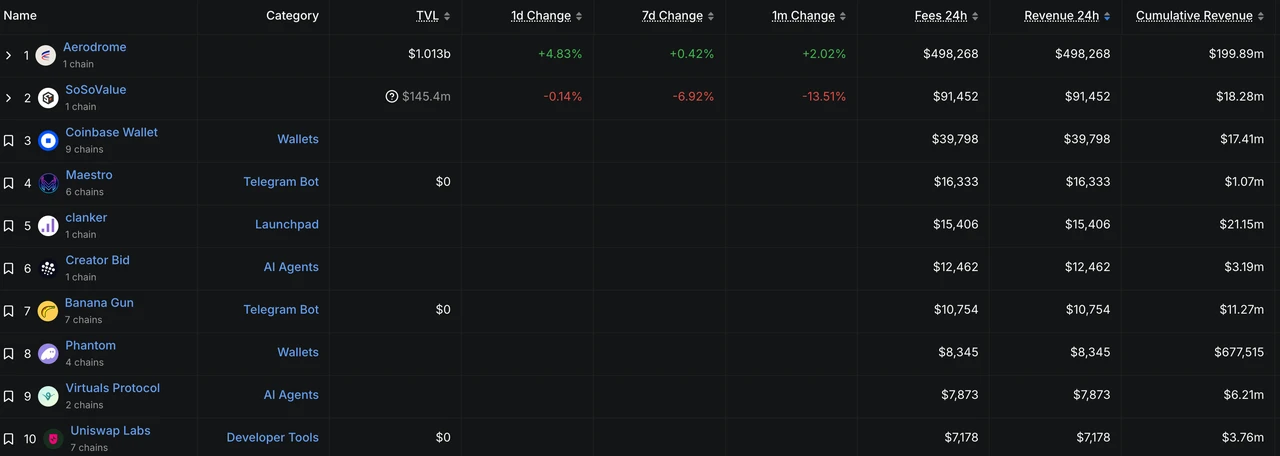
Ranking of Base Ecosystem Projects by Revenue (Data Source: https://defillama.com/chain/base)
From the above chart, it is evident that Aerodrome ranks first in project revenue among all projects on the Base chain, with daily revenue around $500,000 (averaging about $600,000 daily).

Ranking of Base Ecosystem DEX Projects by Trading Volume (Data Source: https://defillama.com/chain/base)
From the above chart, it can be seen that Aerodrome's trading volume has far exceeded that of Uniswap, reaching $525 million (with an average daily trading volume of around $600 million), ranking first among DEX projects in the Base ecosystem.

AERO Token Holding Addresses (Data Source: https://dune.com/thechriscen/aerodrome-analysis)
From the above chart, it can be seen that the number of addresses holding AERO tokens has rapidly increased following Coinbase's announcement of integrating the DEX on the Base chain into its main application, indicating that this policy has encouraged users to hold AERO tokens.
Summary
From the analysis of Coinbase's integration of the Base chain DEX, on-chain data shows that theoretical analysis aligns closely with actual data, validating the real effectiveness of the positive news: after the announcement of the integration policy, Aerodrome's trading volume surged to an average of $600 million, surpassing Uniswap, project revenue remained at the top of the Base chain at an average of $600,000, TVL rebounded by 56% to exceed $1 billion, and the number of AERO holding addresses rapidly increased, with data clearly reflecting Coinbase's trading time characteristics, directly confirming the capital inflow effect.
Bearish Targets: ALT, REZ
ALT: Token Unlock Risk Warning and Price Downward Trend Analysis Under Triple Pressure
Project Fundamental Analysis
AltLayer, as a decentralized elastic Rollup-as-a-Service (RaaS) protocol, focuses on providing scalable second-layer solutions for blockchain applications. The project has certain innovations and practical value at the technical level, but currently faces significant challenges due to adverse market conditions.
Deteriorating Market Environment Factors
The overall performance of the Ethereum ecosystem is currently weak, and skepticism regarding Layer-2 solutions is increasing. The main issues focus on Layer-2 being seen as a root cause of the stagnation in the development of the Ethereum ecosystem, leading to severe fragmentation of market liquidity. This negative market sentiment directly impacts the market performance and capital inflow of all Layer-2 related projects, including AltLayer.
Decline in Project Usage and Attention
Due to the overall decrease in interest in the Layer-2 sector, AltLayer, as a RaaS project, has significantly insufficient actual usage, with market attention and capital injection showing a notable decline. This vicious cycle further weakens the project's fundamental support and market confidence.
Token Unlock Pressure Analysis
Unlock Scale and Timing: On June 25, 195 million ALT tokens will be unlocked, accounting for 1.95% of the total locked amount, which is relatively large.
Unlock Beneficiary Structure: According to the linear unlock chart in the white paper, the main beneficiaries of this unlock are investment institutions and the project team, who typically have strong motivations to cash out.
Summary
Considering the triple pressure of a deteriorating market environment, declining project attention, and large token unlocks, ALT tokens face significant price downward risks. Potential selling behavior from institutions and teams may trigger a chain reaction in a market environment with limited liquidity, significantly impacting token prices.
REZ: Price Downward Risk Analysis Due to Deteriorating Fundamentals and Large Unlocks
Project Fundamentals and Positioning
Renzo, as a liquidity re-staking protocol based on the EigenLayer ecosystem, aims to simplify complex staking mechanisms for end users and facilitate rapid collaboration with EigenLayer node operators and Active Validation Services (AVS). The project relies on EigenLayer's innovative infrastructure for its technical architecture, possessing certain ecological value and application prospects.
External Environment Pressure Analysis
Overall Weakness in the Ethereum Ecosystem: The current performance of the Ethereum ecosystem remains sluggish, directly affecting the activity and capital inflow of the entire Ethereum DeFi ecosystem.
Shrinkage of the Staking Market: The ETH staking rate has dropped to 28.35%, reflecting a lack of confidence in staking yields, which directly impacts the foundational demand for the Restaking sector, causing related projects to lose market attention and capital support.
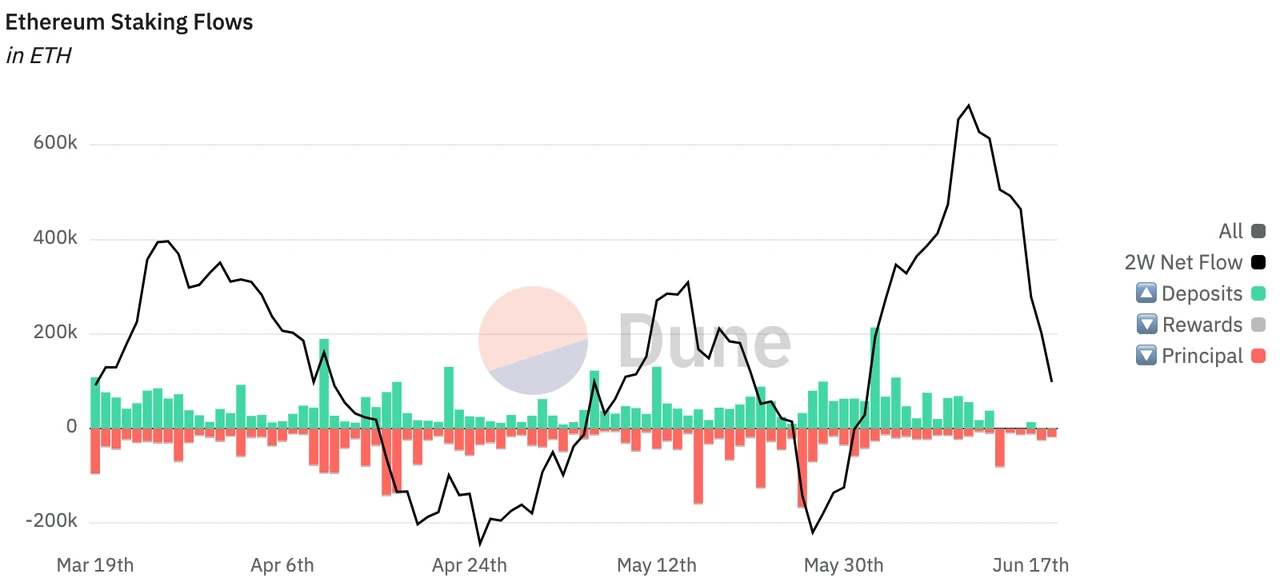
Flow of ETH Staking Funds (Data Source: https://dune.com/hildobby/eth2-staking)
Deterioration of Project Operating Data
Significant Shrinkage of TVL: Renzo's TVL has plummeted from $1.83 billion at the beginning of the year to $945 million, a decline of nearly 50%, reflecting ongoing capital outflows and severe market confidence issues.

Renzo's TVL (Data Source: https://defillama.com/protocol/renzo?revenue=false&devMetrics=false&devCommits=false&tvl=true&fees=false)
Continuous Decline in Revenue: The project's average daily revenue remains at a low level of around $5,000, showing a continuous downward trend, indicating a significant decline in user activity and protocol usage. The ongoing deterioration of revenue data directly reflects the decreasing frequency of market users utilizing the Renzo protocol, creating a negative feedback loop.

Renzo Project Revenue (Data Source: https://defillama.com/protocol/renzo?revenue=true&devMetrics=false&devCommits=false&tvl=false&fees=false)
Token Unlock Risk Assessment
Unlock Scale and Structure: On June 29, 423 million REZ tokens will be unlocked, accounting for 4.24% of the total locked amount. Considering the current total circulation rate of only 32.63%, this unlock will significantly increase the market supply.
Unlock Beneficiary Risks: According to the linear unlock plan in the white paper, this unlock mainly involves investment institutions and the project team, who have strong motivations and selling pressure to cash out in the current market environment.
Insufficient Market Absorption Capacity: In the context of a sluggish Restaking sector with few participants, the daily trading volume of REZ tokens is only around $2.25 million, indicating a severe lack of market capacity to absorb the increased supply of large tokens.
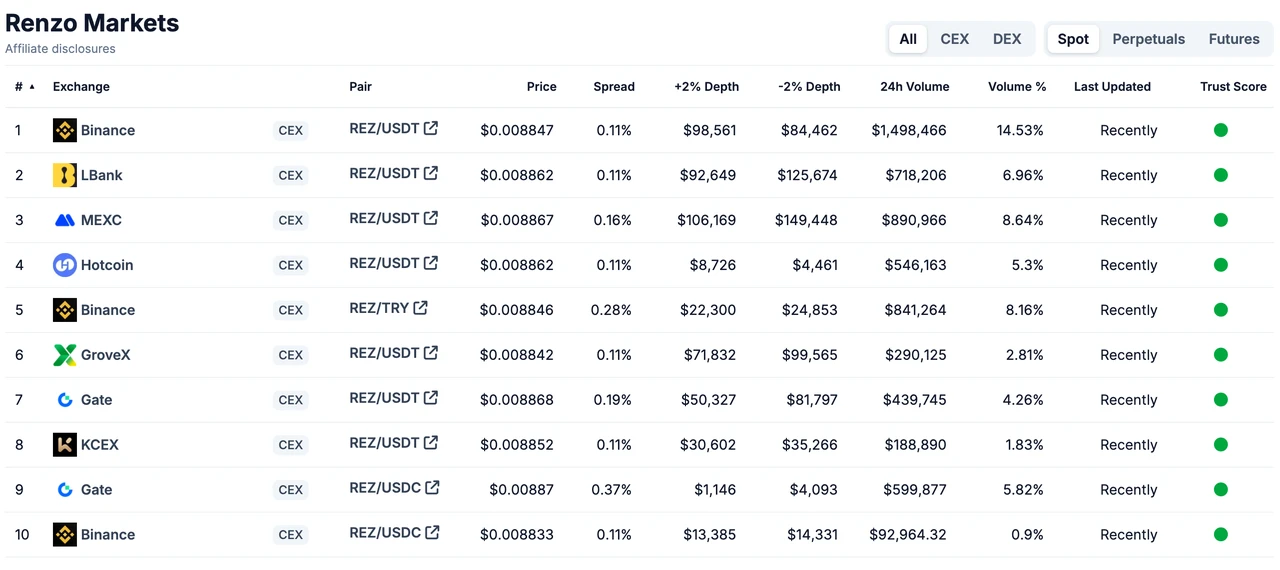
Daily Trading Volume of REZ Tokens (Data Source: https://www.coingecko.com/en/coins/renzo)
Summary
Renzo faces challenges from a deteriorating macro environment, continuously worsening fundamental data, and large token unlocks. In the context of weak performance in the Ethereum ecosystem, with both project TVL and revenue declining, the concentrated unlock of 423 million REZ tokens may trigger severe selling pressure, significantly impacting token prices.
Market Sentiment Index Analysis
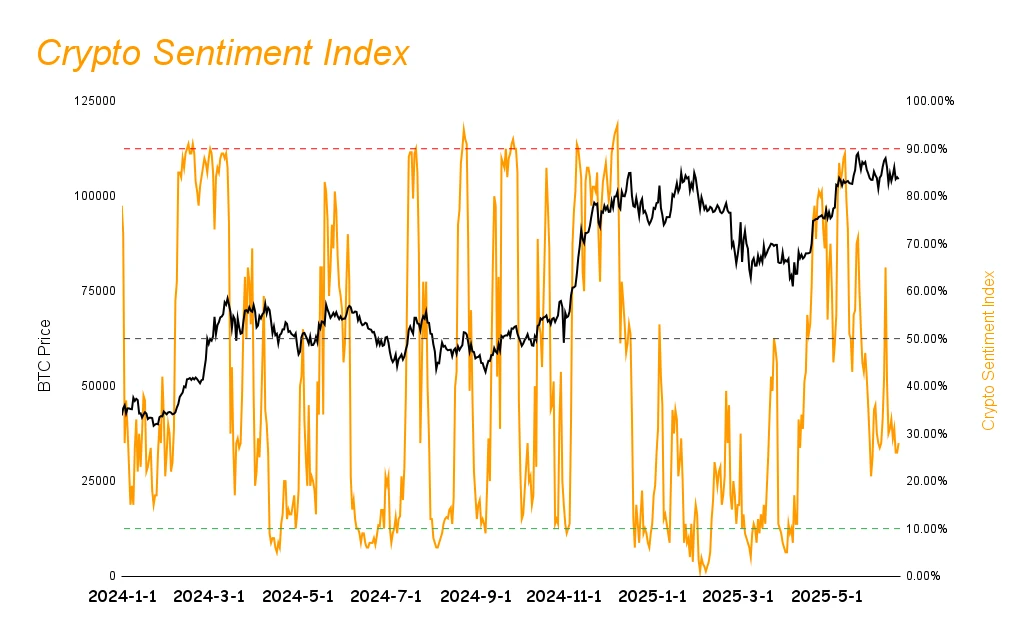

TOTAL3 (Data Source: https://cn.tradingview.com/chart/KBpzaW4x/?symbol=ICEUS%3ADXY)
The market sentiment index has slightly decreased from 30% last week to 28%. BTC has dropped 0.78% this week, ETH has dropped 0.97%, and TOTAL3 has increased by 0.73% this week. Altcoins are overall in a bearish range, maintaining a state of panic.
Overall Market Overview
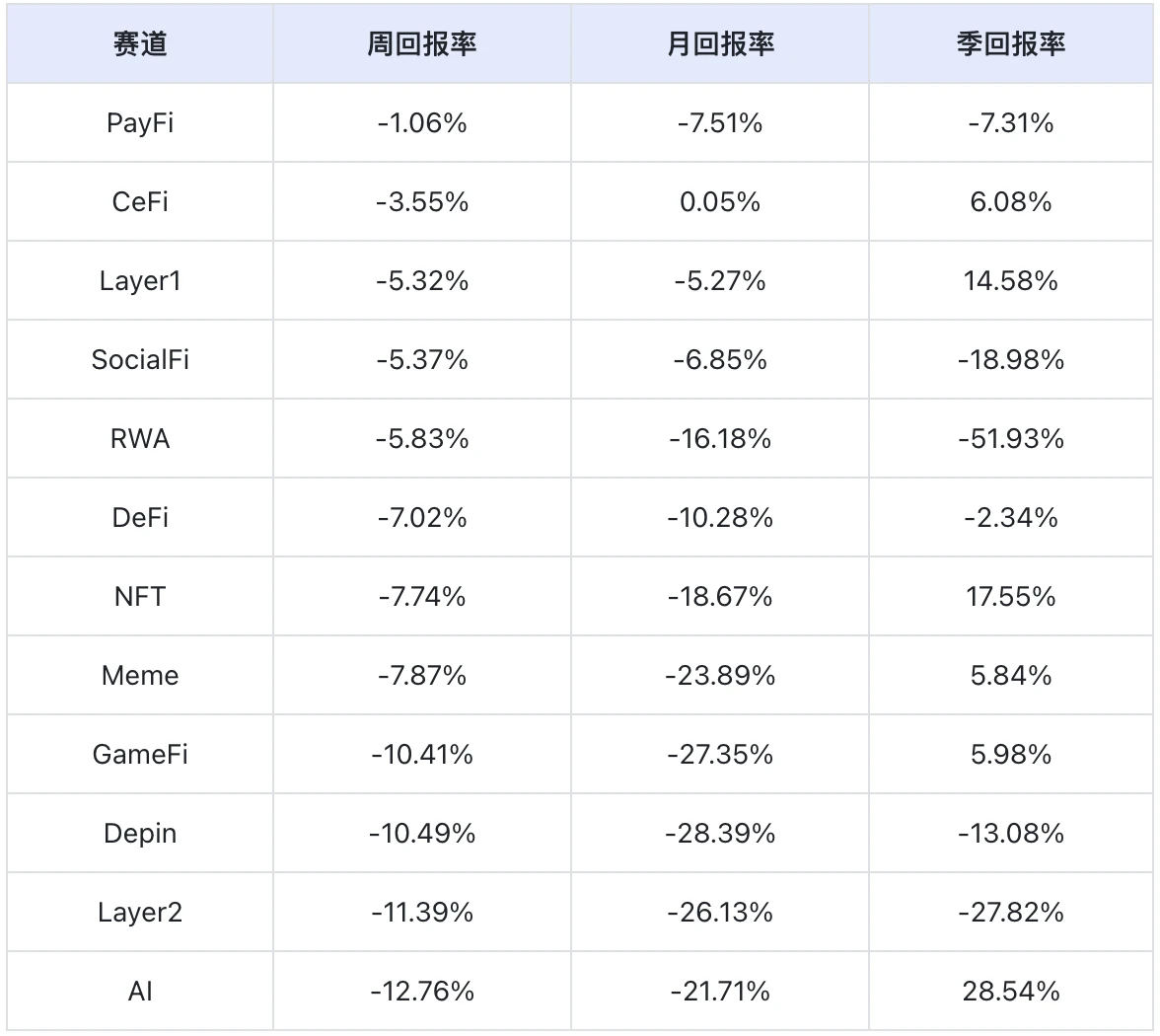
Data Source: SoSoValue
In terms of weekly return rates, the PayFi sector performed the best, while the AI sector performed the worst.
PayFi Sector: In the PayFi sector, XRP, BCH, XLM, and LTC account for a large proportion, totaling 99.09%. This week, their price changes were: -3.41%, 12.35%, -8.96%, and -3.12%, respectively. It can be seen that the projects in the PayFi sector have mixed performance, with those performing better than other sectors still showing a downward trend, making the PayFi sector the best performer.
AI Sector: In the AI sector, TAO, FET, RENDER, WLD, VIRTUAL, and FARTCOIN account for a large proportion, totaling 91.63%. This week, their price changes were: -10.79%, -7.96%, -14.59%, -12.28%, -17.68%, and -20.83%, respectively. It can be seen that the average decline is higher than that of projects in other sectors, making the AI sector the worst performer.
Upcoming Major Crypto Events Next Week
Monday (June 23): NFT NYC 2025 held in New York, USA
Tuesday (June 24): Federal Reserve Chairman Powell delivers semi-annual monetary policy testimony in the House of Representatives
Friday (June 27): U.S. Core PCE Price Index for May; Final Consumer Confidence Index for June from the University of Michigan
Summary
This week, the cryptocurrency market has shown a structural decline under multiple negative factors, with the market sentiment index slightly decreasing from 30% to 28%, entering a bearish range. Although the stablecoin market maintains a growth trend, the incremental funds for USDT have fallen below the $1 billion threshold for the first time, reflecting a significant weakening of capital inflow intensity, while the slight rebound of USDC suggests that U.S. funds are beginning to tentatively enter the market. Geopolitical risks, the Federal Reserve's hawkish stance, and the fundamental differentiation across sectors collectively constitute the triple pressure currently facing the market.
In the current market environment, investment strategies should focus on accurately grasping structural opportunities and effectively avoiding risks. AERO, as the leading DEX in the Base ecosystem, benefits from the catalyst of Coinbase's integration policy, with on-chain data validating its significant improvements in trading volume, revenue, and TVL, representing a typical case of seeking policy-driven growth in a highly uncertain market.
Looking ahead to the next week, investors should closely monitor Powell's monetary policy testimony on June 24, the core PCE data on June 27, and the latest developments in the geopolitical situation in the Middle East. These key events will directly impact market risk appetite and liquidity expectations. It is recommended to adopt a "defensive first, selective second" strategy, focusing on high-quality targets with policy catalysts and fundamental improvements while maintaining a high level of vigilance towards projects facing large unlocks. Through precise risk management and opportunity identification, investors can seek stable returns in a challenging market environment.
Company Introduction
Weekly cryptocurrency market insights produced by FrontierLab. If you wish to receive updates regularly or stay in touch, feel free to contact us.
Explore more → frontierlab.xyz | Contact us → @FrontierLab_ZH
免责声明:本文章仅代表作者个人观点,不代表本平台的立场和观点。本文章仅供信息分享,不构成对任何人的任何投资建议。用户与作者之间的任何争议,与本平台无关。如网页中刊载的文章或图片涉及侵权,请提供相关的权利证明和身份证明发送邮件到support@aicoin.com,本平台相关工作人员将会进行核查。



